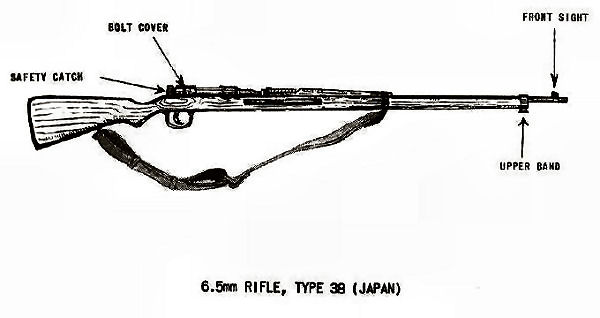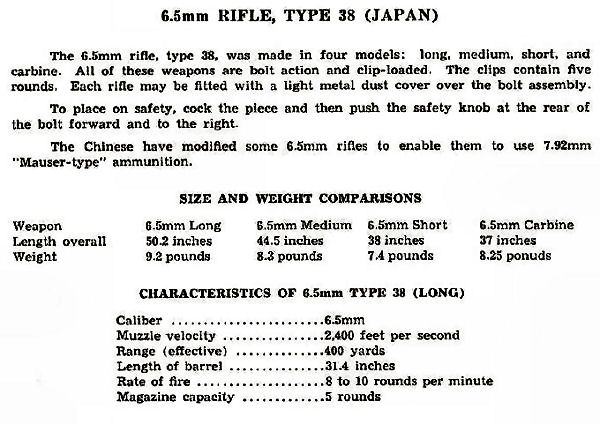WWII Japanese Rifles in Korean War
The Japanese 6.5mm (.25 cal) weapons were all turn bolt operated, with 5-round non-detachable staggered row box magazines. They were loaded with 5-round stripper clips, a flat metal piece holding a five-round stack, which was inserted at the top of the magazine, the rounds thumbed down into position, and the metal piecesent flying when the bolt was closed. The Type 38 Rifle weighed 9.25 lb, and was 50.2 in. long with a 31.4 in barrel. The Type 30 Carbine weighed 7.3 lb and was 34.2 in long. The muzzle velocity was about 2400 fps. A Type 44 Carbine was also made, with a fixed, foldable bayonet, thus weighing 1.6 lb. more than the Type 30.
These rifles had light recoil and little muzzle flash, compared to western rifles, werevery rugged, and generally more suitable to the smaller physique of the Japanese soldier of WWII. Although of light hitting power, the 6.5mm rounds tumbled in flight and broke up upon impact, causing great damage.
At the conclusion of WWII, the Chinese and North Korean Communists inherited large quantities of Japanese weapons from the Soviets, who had taken them in Manchuria/Korea. These used mostly 6.5mm, 7.7mm and 12.7mm ammo. North Korea began its assault on the South still partly armed with these Japanese weapons, but mostly equipped with Soviet weapons like the PPSh M-1941 7.62mm submachine gun (burp gun).
The Chinese had also captured large numbers of weapons from the Nationalists, mostly 7.92mm, but including large numbers of US weapons, .30 cal, .45 cal. and .50 cal. When China entered the Korean War, they had far more of these weapons than Soviet material. However, as the war progressed, battle losses, breakage, and the difficulties of fighting a general war with a crazy quilt of weapons and munitions resulted in the Chinese ending the war with far more Soviet weapons than any other type. China bought all the weapons they received from the USSR, whether thiswas necessary or not, clearly establishing the independence of their emerging nation from any foreign power, even one of similar ideology.
The Communists eventually used all the Soviet WWII weapons in Korea, and also put some of these weapons into production, using their own year of adoption as their model designations. E.g., they produced the famous Soviet PPSh as their Type 50, only changing the buttstock, but the Chinese usually used the 35 round detachable box rather than the 71 round drum.
The Japanese also developed a 7.7mm Type 99 rifle, carbine and light machine gun, and 12.7mm and 13.2mm heavy machine guns. All these weapons saw service in Korea by the Communists.
Throughout the KW, most Chinese were armed only with grenades. They were then free to carry ammo and supplies, a vital need in a primarily infantry army which used rapid and concealed movement as a major weapon. The CCF were veterans, very experienced in identifying enemy weak points, and stealthily approaching them at night, undetected. Then, to a wild cacophony of bugles and whistles, assault platoons armed with grenades, accompanied by other platoons armed with submachine guns, attacked with great violence and effectiveness at close range.
Early in the Korean War a Chinese regiment of 3,000 men typically had only 1,000 to 1400 weapons of all types.
There were many interesting similarities between the psychology of the Japanese Imperial Army and the CCF. Both relied on the determination, endurance and fightingspirit of their men to overcome weaknesses in weapon design and multiplicity of ordnance requirements. Both believed the primary factor in war was the will to fightand die that characterized their soldiers. Both achieved great success, initially, against the superior weapons, and less martially resolute, infantry of the west. Botheventually were stopped by our superior weapons, once our infantry gained experience and combat discipline.





